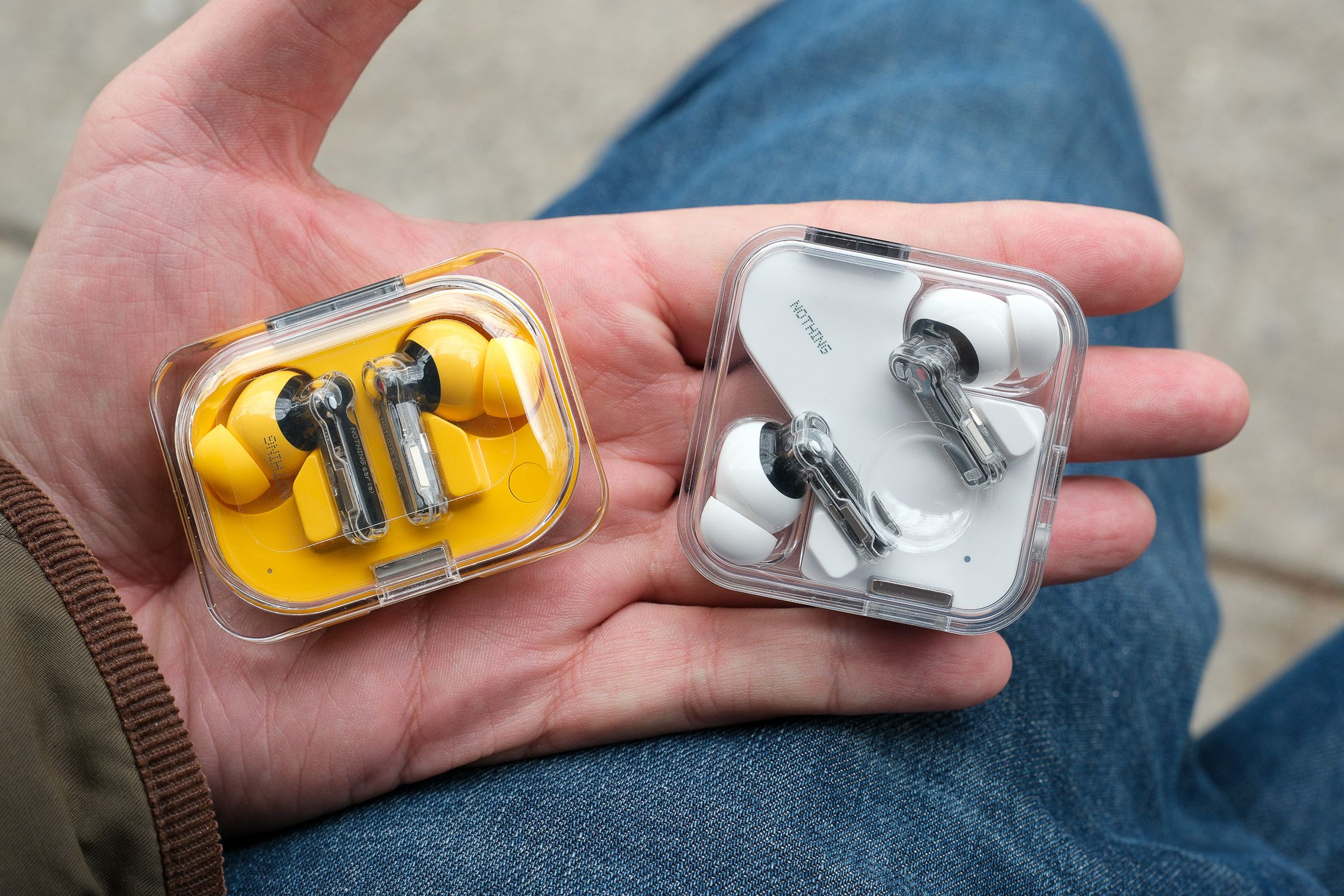Nothing is churning out new earbuds at a faster clip than smartphones. The company just introduced the Nothing Ear and Nothing Ear (a), priced at $149 and $99, respectively. Together, they mark Nothing’s fourth and fifth products in the headphone category. First came the original Ear 1, which stood out for its partly transparent design but suffered from bugs and inconsistent audio performance. Then, Nothing went after a different audience with the open-style (and oddly named) Ear Stick. And a year ago, the company shored up reliability and sound quality concerns with the Ear 2. Now it’s back for another go-round.
The Nothing Ear and Ear (a) both preserve the design that debuted in 2021, with the improvements again focused on day-to-day performance. On the flagship Ear buds, the sound profile was tweaked once more and includes new personalization options, and their battery life has been extended by 25 percent. And there’s a new Bass Enhance setting for giving the low end some extra kick when desired.

:format(webp)/cdn.vox-cdn.com/uploads/chorus_asset/file/25406202/DSCF6918.jpg)
:format(webp)/cdn.vox-cdn.com/uploads/chorus_asset/file/25406202/DSCF6918.jpg)
Meanwhile, the more affordable Nothing Ear (a) adds a splash of color to a Nothing device for the first time: they’re available in yellow in a hue that’s rather close to the adorable Playdate. But the earbuds themselves look just like the pricier Ears, right down to the components you can see through the transparent part of the stem. And they feel identical to the Ear 2 once you put them in. They’re comfortable, but Nothing only includes three sizes of silicone tips, which doesn’t always cover the full spread of ear sizes.
And the similarities extend to how they function. Both have the same strength of active noise cancellation and are able to muffle out up to 45dB of noise, which is twice what the Ear 2 were capable of. Both pairs of earbuds are IP54 dust and water-resistant, although the Ear’s case is more resilient, with a IP55 rating compared to IPX2 rating for the smaller Ear (a) case. Spending more on the Nothing Ear also nets you wireless charging. But in terms of feel, I prefer the more compact Ear (a) case, which the company says was inspired by “everyday pill packets.” It’s more fun! Nothing has improved voice call performance and AI voice isolation on both sets of buds, as well.

:format(webp)/cdn.vox-cdn.com/uploads/chorus_asset/file/25406199/DSCF6920.jpg)
:format(webp)/cdn.vox-cdn.com/uploads/chorus_asset/file/25406199/DSCF6920.jpg)
Where the Nothing Ears win out is in audio fidelity and the level of customization you can apply to it. Nothing says the Ear has its “most advanced” driver system yet, which uses a ceramic diaphragm “rarely seen in audio products” for improved richness. It also partnered with a company called Mimi for a hearing test in the Nothing X app that creates a personal sound profile for your unique hearing traits. I’ve mostly stuck with the “advanced” EQ, which lets you adjust a graphical interface and create profiles for different musical genres. Once the Nothing Ears are out, you’ll be able to share your preferred presets with other owners (and import theirs) by way of QR code.

:format(webp)/cdn.vox-cdn.com/uploads/chorus_asset/file/25406209/DSCF6923.jpg)
:format(webp)/cdn.vox-cdn.com/uploads/chorus_asset/file/25406209/DSCF6923.jpg)
So far, I’ve been very satisfied by how the Nothing Ears sound. The Ear 2 were already on the mark, so these aren’t too different. Can they compete with every trick that Apple, Samsung, Google, and others are offering? No. There’s no head tracking spatial audio, for example.
But from an audio quality perspective, they’re going toe to toe with earbuds from companies with far more resources. And that’s not to say that the Ear (a) sounds bad by comparison. It’s honestly in the same ballpark, so you’re not sacrificing much if you really want Nothing’s colorful buds.
And you’re still getting multipoint, Fast Pair (for Android), Microsoft Swift Pair, and a low-latency gaming mode in the cheaper buds. That’s a lot of stuff crammed in for $99. Battery life has also been totally sufficient, lasting for over five hours on both buds with ANC enabled or well over eight hours if you can go without it.
So as it stands right now, both of Nothing’s new earbuds are a very solid value. And they’ll become more capable in the months to come: the company plans to add ChatGPT integration to its smartphones and earbuds, which will let you query the AI through voice when on the move. I think earbuds are a more compelling vehicle for these interactions, so I’m excited to test how it all comes together once that update is available.
Photography by Chris Welch / The Verge
















